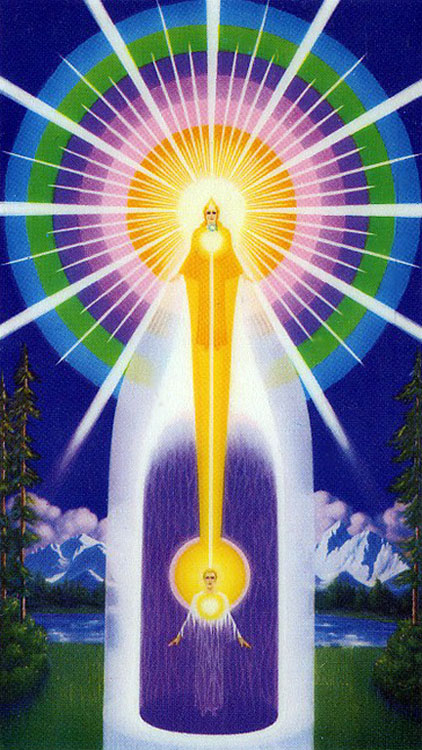The Chart of the Magic Presence is the visual synopsis of the self-centered teleology of “I AM,” a new religious movement founded in 1932 by Guy and Edna Ballard. Designed by “I AM” follower May DaCamara in 1935, the color saturated Chart depicts the movement’s holy sites on the lower tier (Mount Shasta, California, is at the left) and focuses on two figures connected by a golden “Ray of Light and Energy.” The bottom figure, encased within a milk-bottle shaped “Invincible Wall of Light” and surrounded by Violet Flame, represents the human or flesh body; the upper figure, haloed by circles of color and emanating rays of light, embodies the desired “I AM” Presence.
Use of the Chart was deemed imperative in “I AM,” and the Saint Germain Press, which the Ballards established in Chicago, sold mail-order pictures priced from one to fifteen dollars. In 1939, an electronically animated Chart in Action was manufactured, which included Violet Flame side panels lit by 40-watt bulbs; these were available in 20 and 50-inch sizes for $50 and $200 each. The Chart’s curative properties were emphasized: adherents were instructed to stare at it for hours in order to heal themselves of “discord and imperfection.” As “I AM’s” in-house magazine, The Voice of “I AM,” asserted in 1937: “Every one, who has ever accomplished the Ascension, Jesus included, had to use this Violet Consuming Flame to dissolve his own human creation, before the Substance of his flesh body could vibrate at a rate that would enable it to ascend.”
During the interwar era, a number of new religious movements emerged in the United States. Ranging from Sister Aimee Semple McPherson’s Foursquare Gospel Church (founded in 1922) and Father Divine’s Peace Mission Movement (founded in 1932) to William Dudley Pelley’s Silver Legion of America (1933), Psychiana (1929), and the Lemurian Fellowship (1936), many New Religious Movements attracted impressive numbers of followers, widespread media attention, and considerable wealth. Their appeal seemingly threatened more mainstream religions and notions of social and political order. The federal government charged some of the movements with tax evasion, mail fraud, and "bogus" religious claims. Yet, in 1944, the U.S. Supreme Court affirmed that religious doctrine, whether new or established, fringe or majority, does not have to be proven: that no religion in America is right or wrong, or true or false.
The new religious movement that instigated this monumental legal decision was “I AM.” The Ballards claimed to be divinely appointed by Ascended Master Saint Germain, an eighteenth-century mystic, to spread the word of spiritual ascension on earth and to help America, in particular, fulfill its destiny as the repository of the forces of “Light,” or goodness. Premised on self-actualization, the prosperity gospel, and spiritual re-embodiment, the new religion emphasized the “Mighty ‘I AM’ Presence,” or the inwardly divine self. Patriotic and politically right wing, “I AM” prominently featured the U.S. flag and the Statue of Liberty in its promotional materials, picturing America in messianic terms. Screeds (or “decrees”) against Communists, labor activists, and New Dealers were frequent; more avid devotees were instructed, for example, to telepathically issue death threats against Franklin Delano Roosevelt.
From 1934-39, the Ballards traveled across America promoting “I AM” to increasingly larger audiences; by the end of the decade, the movement claimed one million adherents. Material and visual cultures were fundamental to “I AM”: followers were encouraged to purchase “I AM” books, records, magazines, pictures of the Ascended Masters, photographs of the Ballards, and, especially, the Chart of the Magic Presence. By 1939, “I AM” had amassed more than $3 million in sales and from “love gifts” donated by adherents eager to receive divine blessings.
Not surprisingly, large sums of tax-free dollars accrued by a non-normative new religion, particularly one that reputedly wanted to off the U.S. president, raised eyebrows. In 1940, “I AM’s” leaders were charged with fraud, with accepting money for products that seemingly bilked believers. On appeal, the case reached the U.S. Supreme Court where, in U.S. v. Ballard, Justice William O. Douglas gave the majority opinion: “It is immaterial what these defendants preached or wrote or taught in their classes ... the price of freedom of religion ... is that we must put up with, and even pay for, a good deal of rubbish.”
“I AM” went into decline in the 1940s, although it is still active. The Chart of the Magic Presence, however, remains highly visible. Co-opted by other new religious movements including the Church Universal and Triumphant (CUT), the Chart can be found on numerous websites: testimony to its sustained appeal as an embodiment of faith.
Notes
Keywords
Imprint
10.22332/con.obj.2014.3
1. Erika Doss, "The Chart of the Magic Presence," Object Narrative, in Conversations: An Online Journal of the Center for the Study of Material and Visual Cultures of Religion (2014), doi:10.22332/con.obj.2014.3
Doss, Erika. "The Chart of the Magic Presence." Object Narrative. In Conversations: An Online Journal of the Center for the Study of Material and Visual Cultures of Religion (2014). doi:10.22332/con.obj.2014.3



